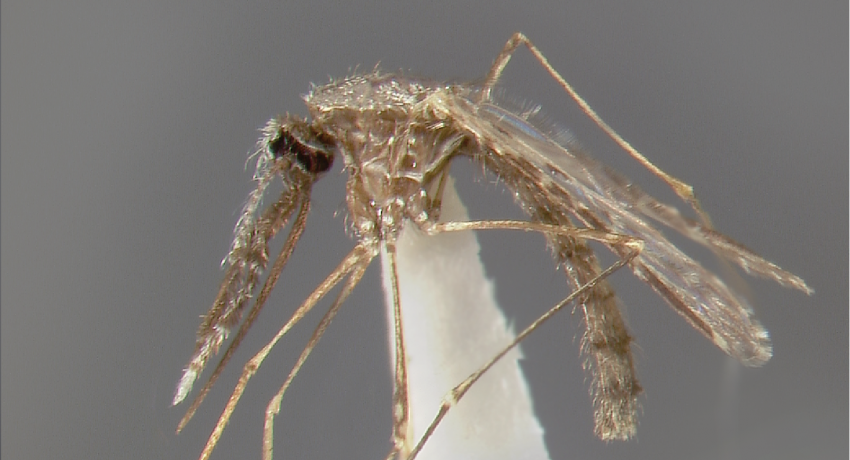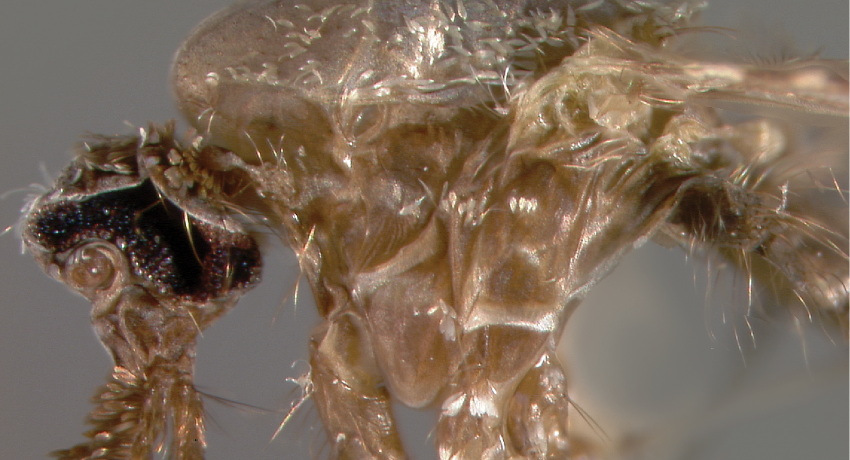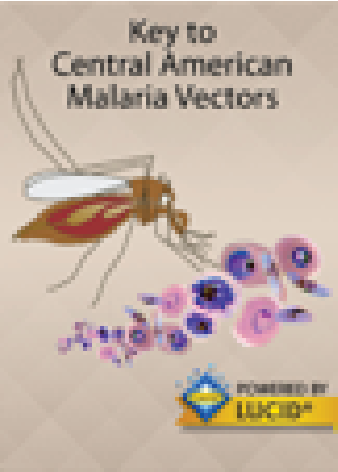NEOTROPICAL REGION
Etymology: not stated [three ringed (L)]
Using allozyme and RAPD evidence, An. triannulatus specimens from Salobra (Mato Grosso do Sul State, Brazil) was shown to comprise three species—An. triannulatus, An. halophylus Silva-do-Nascimento & Lourenço-de-Oliveira, and An. triannulatus C. Females are isomorphic but reliable egg, larva and male genitalia characters exist to differentiate An. triannulatus s.s. and An. halophylus. Anopheles triannulatus C shares morpho-characters of both species, but does not correspond to any of the five valid synonyms of An. triannulatus—bachmanni Petrocchi, chagasi Galvão, cuyabensis Neiva & Pinto, davisi Paterson & Shannon, and perezi Shannon & Del Ponte. In addition, two distinct lineages of An. triannulatus s.l. have been reported from NW and SE Colombia using mtDNA COI and nuclear rDNA ITS2 sequences. Form I is found in both locations, with Form II restricted to southeastern Colombia. It is unclear if either of these forms correspond to the currently defined taxa in the Triannulatus Group.
Type locality: Rio Cuiabá, Fazenda Sao Joao, Mato Grosso, Brazil
Type depository: Location unknown (LU)
DIAGNOSTIC CHARACTERS (Click photos to view; mouse over and click large photo to zoom in.)
ADULT (illustrated): Head: Palpomere MPlp4 with at least some white or cream-colored mediolateral scales, but no yellow scales. Thorax: Anterior mesepimeron with a patch of small white scales. Wing: Accessory sector pale spot about 0.4 from wing base, conspicuously closer to sector pale than to subcostal pale spot; prehumeral dark spot relatively long, extending to the humeral crossvein; subcostal pale spot small; vein 1A with fewer than 5 pale and 5 dark alternating spots. Leg: Fe-III and Ti-III dark with sparse pale scales, not speckled; Ta-III3–4 white; Ta-III5 with basal dark band. Abdomen: Terga covered with scales; II-Te with posterolateral scale tufts.
LARVA (not illustrated): Head: Setae 2-C well-separated, clypeal index <2.5; setae 2,3-C single or aciculate, sometimes apically branched; setae 5–7-C plumose. Thorax: Seta 1-P with narrow lanceolate leaflets; setae 1–3-P not inserted on common tubercle. Abdominal segments: Seta 1 palmate, leaflets smooth-sided; seta 1-I well-developed palmate; seta 11-I long, 3–7 branched; seta 13-I long, 2–4 branched; seta 6-IV, V single. Terminal segments: Median plate with long lateral arms.
TAXONOMIC KEYS
Deane, L.M. et al. 1946
Causey et al. 1946
Deane, M.P. et al. 1946
Belkin et al. 1971
Faran 1980
Sallum, et al. 2020
![]()
Anopheles – Central America – Adult
![]()
Anopheles – Central America – Larva
![]()
WRBU - Genera - Global - Adult
![]()
WRBU - Genera - Global - Larva
![]()
WRBU - Genera - Neotropical - Adult
![]()
WRBU - Genera - Neotropical - Larva
Exemplar DNA sequences
An. triannulatus s.s. COI: JN085964–JN086138, KR909593–KR909665
An. halophylus COI: JN086076, JN086121; ITS2: JF973007–08
An. triannulatus ‘C’ COI: JN086075, JN086077
BIONOMICS
Immatures
Typical habitats for An. triannulatus s.s. immatures are freshwater lakes, ponds or large ground pools populated with water lettuce (Pistia stratiotes Linnaeus), in forest environs. Anopheles halophylus breeds exclusively in brackish water habitats in Salobra, Brazil. In Upper Orinoco, Venezuela, An. triannulatus s.l. immatures are abundant in lagoons with submerged aquatic plants and sparse emergent grasses.
Adults
Adult An. triannulatus s.l. bite early in the night (18:00-21:00). In Trinidad, females are readily collected at human bait, and viciously attack people in the Canal Zone, Panama. In contrast, An. triannulatus populations from Amapá, Brazil are zoophilic and rarely captured biting man. There, blood meal analysis of 154 An. triannulatus revealed preferences for pigs and cattle, with mixed feeding common (15.6%) and only 2% positive for human blood.
DISTRIBUTION NOTES
Argentina, Bolivia, Brazil, Colombia, Costa Rica, Ecuador, French Guiana, Guatemala, Guyana, Nicaragua, Panama, Paraguay, Peru, Puerto Rico, Suriname, Trinidad & Tobago, Venezuela.

WRBU VECTOR HAZARD REPORTS
None; View other WRBU Vector Hazard Reports
Available GIS Models
An_triannulatus_Nyari_1 South & Central America
IMPORTANT REFERENCES (full citations below)
Pinto 1939: 406 (M*, F*, P*, L*, E*; taxonomy)
Komp 1942: 69 (F*), 118 (L*), 156 (M*)
Rozeboom 1942a: 241 (E*)
Floch & Abonnenc 1944 (E*)
Cova García 1946 (as davisi), Fig. 1 (E*), 38 (L*), 90 (F*), 125 (M*)
Deane, L.M. et al. 1946 (F*, key, bionomics; NE Brazil & Amazonas)
Causey et al. 1946 (M*, key ; NE Brazil & Amazonas)
Deane, M.P. et al. 1946 (L*, key, bionomics; NE Brazil & Amazonas)
Belkin et al. 1971: 6 (taxonomy)
Faran 1980: 141 (M*, F*, P*, L*; keys, taxonomy, bionomics, distribution)
Conn 1991 (chromosomes)
Lounibos et al. 1997a (E*)
Chadee & Wilkerson 2005 (distribution; Trinidad & Tobago)
Zimmerman et al. 2006 (bionomics)
Silva-do-Nascimento et al. 2006 (molecular taxonomy; sensu lato)
Silva-do-Nascimento et al. 2011 (molecular taxonomy; sensu lato)
Rosero et al. 2012 (molecular taxonomy; sensu lato, distribution; Colombia)
Moreno et al. 2013 (phylogeography; sensu lato)
Berti et al. 2015 (distribution; Venezuela)
Sallum, et al. 2020 (keys F, M, L)
CURRENT SYNONYMS
syn. cuyabensis Neiva & Pinto
1923: 235 (F*; Cellia). Type locality: Rio Cuiabá, Fazenda Sao Joao, Mato Grosso, Brazil (IOC). References: Pinto 1939: 406 (synonymy); Belkin et al. 1971: 7 (lectotype designation).
syn. bachmanni Petrocchi
1925: 69 (M*, F*). Type locality: Corrientes, Entre Rios, Formosa, Argentina (NE). References: Pinto 1939: 406 (synonymy); Cova García 1961: 39, 91, 128 (M*, F*, L*, E*; from synonymy as subspecies); Faran 1980: 141 (from subspecies of triannulatus to synonym of triannulatus).
syn. davisi Paterson & Shannon
1927: 5 (M, F, L; as sp.). Type locality: Tres Pozos, Embarcacion, Salta, Argentina (USNM). References: Galvão 1940: 412 (L*, E*; to subspecies); Stone & Knight 1956b: 277 (type information); Faran 1980: 141 (from synonymy with bachmanni to synonymy with triannulatus).
syn. perezi Shannon & Del Ponte
1928 (1927): 56 (F). Type locality: Santa Barbara, Tucuman, Argentina (NE). References: Pinto 1939: 406 (synonymy); Faran 1980: 141 (from synonymy with bachmanni to synonymy with triannulatus).
syn. chagasi Galvão
1941a: 92 (F, E*; as variety). Type locality: Manaus, Brazil (LU). References: Belkin et al. 1971: 7 (type locality information); Lane 1949 (synonymy).
CITED REFERENCES
Belkin, J.N., Schick, R.X., & Heinemann, S.J. (1971). Mosquito studies (Diptera, Culicidae). XXV. Mosquitoes originally described from Brazil. Contributions of the American Entomological Institute, 7(5), 1–64.
Berti, J., Guzmán, H., Estrada, Y., & Ramírez, R. (2015). New records of mosquitoes (Diptera: Culicidae) from Bolívar State in South Eastern Venezuela, with 27 new species for the state and 5 of them new in the country. Frontiers in Public Health, 2, 10.
Causey, O.R., Deane, L.M., & Deane, M.P. (1946). An illustrated key by male genitalic characteristics for the identification of thirty-four species of Anophelini from the northeast and Amazon regions of Brazil, with a note on dissection technique. American Journal of Hygiene Monograph Series, 18, 21–31.
Chadee, D.D., & Wilkerson, R.C. (2005). Anopheles triannulatus (Neiva and Pinto): a new Anopheles record from Trinidad, West Indies. Journal of the American Mosquito Control Association, 21(3), 316–317.
Conn, J. (1991). A cytogenetic analysis of the polytene chromosomes of Anopheles triannulatus (Diptera, Culicidae) from western Venezuela. Genome, 34(2), 267–272.
Cova García, P. (1946). Notas sôbre los anofelinos de Venezuela y su identificacion. (CSP12/C1). Editorial Grafolit.
Deane, L.M., Causey, O.R., & Deane, M.P. (1946). I. An illustrated key by adult female characteristics for the identification of thirty-five species of Anophelini, with notes on the malaria vectors (Diptera, Culicidae). In Studies on Brazilian anophelines from the northeast and Amazon regions (pp. 1–18). Baltimore: The Johns Hopkins Press.
Deane, M.P., Causey, O. R., & Deane, L.M. (1946). III. An illustrated key by larval characteristics for the identification of thirty-two species of Anophelini, with descriptions of two larvae. In :Studies on Brazilian anophelines from the northeast and Amazon regions (pp. 33–50). Baltimore: The Johns Hopkins Press.
Faran, M.E. (1980). Mosquito studies (Diptera: Culicidae) XXXIV. A revision of the Albimanus section of the subgenus Nyssorhynchus of Anopheles. Contributions of the American Entomological Institute, 15(7), 1–215.
Floch, H., & Abonnenc, E. (1944). A. triannulatus Neiva et Pinto en Guyane Franҫaise morphologie des oeufs et infection experimentale par P. falciparum et P. vivax. Archives de l'Institut Pasteur de la Guyane française et du Territoire de l'Inini, 77, 1–7.
Komp, W.H.W. (1942). The anopheline mosquitoes of the Caribbean Region. National Institute of Health Bulletin No. 179.
Lane, J. (1949). Anophelines of the Neotropical Region, pp. 399-418. In: M.F. Boyd (ed). Malariology. W.B. Saunders, Philadelphia.
Lounibos, L.P., Duzak, D., & Linley, J.R. (1997a). Comparative egg morphology of six species of the Albimanus Section of Anopheles (Nyssorhynchus) (Diptera: Culicidae). Journal of Medical Entomology, 34(2), 136–155.
Moreno, M., Bickersmith, S.A., Harlow, W., Hildebrandt, J., McKeon, S.N., Silva-do-Nascimento, T.F.., . . . Conn, J. E. (2013). Phylogeography of the neotropical Anopheles triannulatus complex (Diptera: Culicidae) supports deep structure and complex patterns. Parasites & Vectors, 6, 47.
Pinto, C. (1939). Disseminacão da malaria pela aviacão; biologia do Anopheles gambiae e outros anofelineos do Brasil. Memórias do Instituto Oswaldo Cruz, 34, 293 430.
Rosero, D.A., Jaramillo, L.M., Gutiérrez, L.A., Conn, J.E., & Correa, M.M. (2012). Genetic diversity of Anopheles triannulatus s.l. (Diptera: Culicidae) from Northwestern and Southeastern Colombia. The American Journal of Tropical Medicine and Hygiene, 87(5), 910–920.
Rozeboom, L.E. (1942a). Subspecific variations among Neotropical Anopheles mosquitoes, and their importance in the transmission of malaria. American Journal of Tropical Medicine and Hygiene, 22, 235–255.
Sallum, M.A.M., Obando, R.G., Carrejo, N. et al. Identification key to the Anopheles mosquitoes of South America (Diptera: Culicidae). Parasites and Vectors, 13, 542 (2020). https://www.biomedcentral.com/collections/id-keys-anopheles
Silva-do-Nascimento, T.F., Rona Pitaluga, L.D., Peixoto, A.A., & Lourenço-de-Oliveira, R. (2011). Molecular divergence in the timeless and cpr genes among three sympatric cryptic species of the Anopheles triannulatus complex. Memórias do Instituto Oswaldo Cruz, 222(Suppl 1), 1.
Silva-do-Nascimento, T.F., Wilkerson, R.C., Lourenço-de-Oliveira, R.., & Monteiro, F.A. (2006). Molecular confirmation of the specific status of Anopheles halophylus (Diptera: Culicidae) and evidence of a new cryptic species within An. triannulatus in Central Brazil. Journal of Medical Entomology, 43, 455–459.
Stone, A., & Knight, K.L. (1956b). Type specimens of mosquitoes in the United States National Museum. III. The genera Anopheles and Chagasia (Diptera, Culicidae). Journal of the Washington Academy of Sciences, 46(9), 276–280.
Zimmerman, R.H., Galardo, A.K., Lounibos, L.P., Arruda, M., Wirtz, R. (2006). Bloodmeal hosts of Anopheles species (Diptera: Culicidae) in a malaria-endemic area of the Brazilian Amazon. Journal of Medical Entomology, 43, 947-956.
CITE THIS PAGE
Walter Reed Biosystematics Unit (Year). Anopheles triannulatus species page. Walter Reed Biosystematics Unit Website, http://wrbu.si.edu/vectorspecies/mosquitoes/triannulatus, accessed on [date (e.g. 03 February 2020) when you last viewed the site].











































































































































































